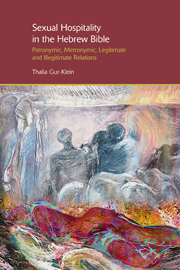 Sexual Hospitality in the Hebrew Bible
Sexual Hospitality in the Hebrew Bible Book contents
- Frontmatter
- Contents
- Acknowledgements
- Introduction
- 1 Patriarch hospitality and sexual hospitality
- 2 Marital and non-marital systems
- 3 Baal marriage of dominion
- 4 Metronymic marriage: remaining with kin – counter-patterns of baal marriage
- 5 Intersecting patterns and conflicting imperatives
- 6 Widow marriage, land and kin surrogacy
- Epilogue: moral imagination
- Notes
- Bibliography
- Index
5 - Intersecting patterns and conflicting imperatives
- Frontmatter
- Contents
- Acknowledgements
- Introduction
- 1 Patriarch hospitality and sexual hospitality
- 2 Marital and non-marital systems
- 3 Baal marriage of dominion
- 4 Metronymic marriage: remaining with kin – counter-patterns of baal marriage
- 5 Intersecting patterns and conflicting imperatives
- 6 Widow marriage, land and kin surrogacy
- Epilogue: moral imagination
- Notes
- Bibliography
- Index
Summary
Relating marriage to a spectrum of conjugal patterns problematizes biblical stories. Stories become ambiguous as they represent conjugal patterns that oscillate and intersect one another. However, such texts corroborate the idea that a society itself may practise a number of conjugal patterns side by side and that such coexistence is represented in multifaceted texts. In turn, texts represent a reality which in itself is multilayered and intersected. Resonating with oral tradition and aggregating over centuries, ancient texts themselves culminate as a multilayered corpus. Several systems may exist side by side in one and the same text, incorporating residues of various sources, interweaving them into a story. By inference, systems feature in motifs and are actuated in characters and narrative events, surviving as residual representations of systems. While intersecting and infringing on one another, residual representations of systems intersect, dichotomize, modify and re-modify one another, intertextually complementing, neutralizing and even contradicting one another in texts (on intertextuality, see above).
Biblical texts regarding sexual relations are not necessarily exclusive testimonies of one conjugal form. Resonating with representations which are both multifaceted and fragmented, texts transform marriage and sexual relations into ‘objects charged with contradictions,’ to appropriate Eilberg-Schwartz's words (1992: 18–19). As a corollary, Patai's thesis suggests that the juxtaposition of various systems generates a sense of conflicting imperatives (Patai 1959: 139–45). As each system sets out its objectives, intertextual juxtaposition generates conflicting imperatives and intersection.
- Type
- Chapter
- Information
- Sexual Hospitality in the Hebrew BiblePatronymic, Metronymic, Legitimate and Illegitimate Relations, pp. 205 - 270Publisher: Acumen PublishingPrint publication year: 2013


